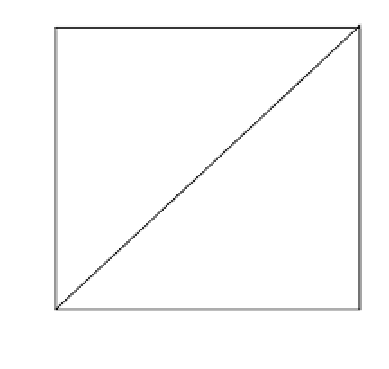Biomedical Engineering Reference
In-Depth Information
θ = 0°
θ = 60°
0.4
0.4
0.3
0.3
0.2
0.2
0.1
0.1
0.0
0.0
0.0
0.1
0.2
0.3
0.4
0.0
0.1
0.2
0.3
0.4
(Fe
ox
+ Cr
ox
)/
Σ
org
(Fe
ox
+ Cr
ox
)/
Σ
org
Fig. 5. Relations between molar concentrations ratioed to the sum of organic elements (Σorg)
measured by XPS at θ = 0° (data from Table 2) and θ = 60° on native (open symbols) or
silanized stainless steel (closed symbols), as such (
¡
,
) or further treated with coupling
agent BS (
S
,
U
), glucose oxidase (
z
,
{
) or coupling agent followed by glucose oxidase
(
,
).
reaction. The different possibilities, corresponding to the relative importance of grafting
with respect to polymerization, are shown in Figure 6 and characterized by a, defined as the
sum, over oxygen atoms which are not bound to a metal element, of the inverse of the
number of bonds oxygen forms with silicon. Accordingly the concentration of inorganic
hydroxide in the passive film may be given as follows:
OH
inorg
= O
tot
- O
org
- O
529.7
- a
×
Si
org
(3)
where
a
can take the values of 0, 0.5, 1, 1.5 or 2 (Figure 6).
Figure 7 shows the plot of the concentration of hydroxide which should be associated with
Fe and Cr, considering different values of
a
. Taking silicon into account (a≠0) brings the
silanized substrates better in line with the non-silanized substrates and the correlation
improves as
a
increases, indicating that silane is polymerized and not just grafted.
Depending on the value of
a
, the
y
:
x
ratio varies from 1.1 (
a
= 0) to 0.8 (
a
= 2).
These observations indicate that the stoichiometry of the Cr and Fe oxyhydroxide at the
surface is close to (Fe,Cr)OOH. Many studies have reported a stratification in the passive
film and the presence of Fe and Cr oxyhydroxides in the outermost layer (Le Bozec et al.,
2001). In our case, no significant effect of the photoelectron collection angle appears in the
OH
inorg
/O
529.7
ratio (Figure 8), whatever the value selected for
a
to evaluate
OH
inorg
. However
it must be kept in mind that the surface roughness revealed by Figure 1, which is of the
order of the inelastic mean free path of photoelectrons in oxides, may mask the effect of a
stratification.

































